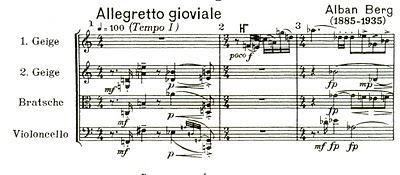 |
| Click to enlarge |
My piece for guitar ensemble that I put up in this post is underdetermined with regard to co-ordination of the different instruments because I wanted to see if I could write a piece that had no ensemble issues. But the overall trend for the last 500 years has been towards more and more specific details in the score such as dynamics (non-existent before the 18th century), rubato, playing techniques, accents, articulation and timbre. Here is an example of a 20th century piece, chosen pretty much at random:
 |
| Click to enlarge |
In this we see a fairly high level of determination: tempo is defined with a metronome marking of 100 beats per minute; nearly every note has a separate dynamic marking (mf); each note also has a specific articulation (. or - or >) indicating a short, long, or accented note; dynamics are often connected with hairpins indicating a swelling or diminishing sound; and later on there is a scattering of additional information such as poco pesante (a bit heavy) and poco marcato (a bit marked).
Greg Sandow has a long and illuminating review up on his blog of a Schoenberg concert in which he talks about the problems performers have with the music and how it is rarely performed both accurately and with heart (musically). I think the reason is that the music is overdetermined. Schoenberg is simply asking for too much control over how the players perform each and every note. If you want to see how truly mad this can get, have a look at a score by Brian Ferneyhough. His piece Cassandra's Dream Song looks like a very complex piece for piano, but is actually for solo flute.
At the other extreme there are composers like Morton Feldman or John Cage who intentionally underdetermine their scores. Here is a page from a piece for four pianos by Feldman:
 |
| Click to enlarge |

No comments:
Post a Comment